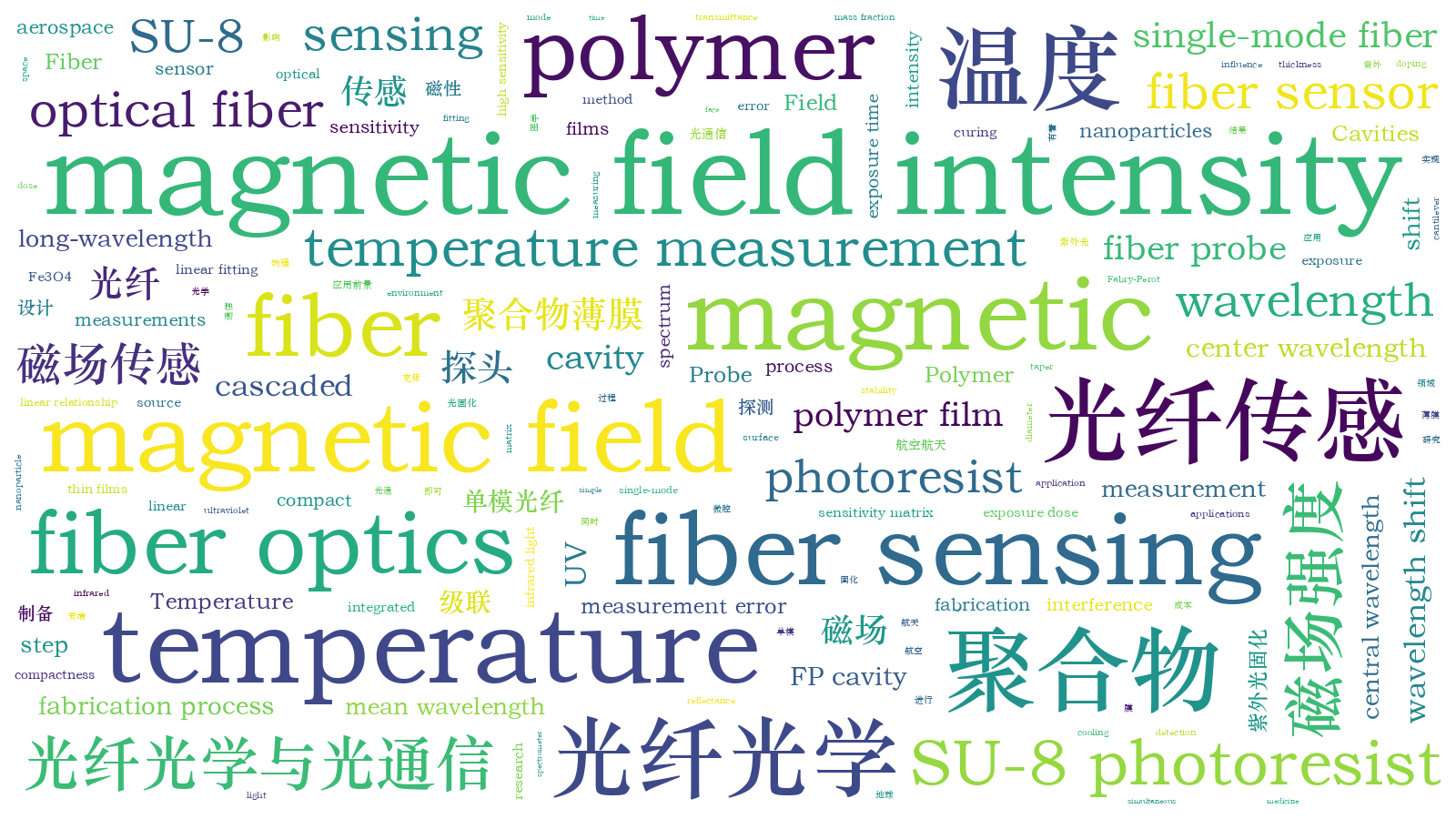基于级联聚合物腔的光纤温度和磁场传感探头  下载: 550次
下载: 550次
A compact fiber sensing probe based on cascaded polymer microcavities is proposed in this paper for measuring magnetic field and temperature. This fiber probe effectively overcomes the influence of temperature on the detection results of magnetic field. There are broad applications in the fields of aerospace, geophysical research, and medicine.
The proposed fiber sensor based on cascaded Fabry-Perot(FP) cavities is fabricated using the method of dipping and ultraviolet(UV) curing. The schematic of fabrication process is shown in Fig. 1. First, the magnetic SU-8 photoresist is achieved by doping 5% mass fraction Fe3O4 nanoparticles into the SU-8 photoresist and then it is ultrasonic vibrated with an ultrasonic agitator at 40 kHz for 2 h. The Fe3O4 nanoparticles can be homogeneously dispersed in the SU-8 photoresist, and the nanoparticle diameter is only around 10 nm. The magnetic SU-8 photoresist has a good transmittance to infrared light. The end-face of single-mode fiber (SMF) is cut flat and dipped into the magnetic SU-8 photoresist. A perfect elliptical polymer film on the end surface of SMF is achieved after the optical fiber is pulled out, which is combined with SMF to form an FP cavity (cavityⅠ). The maximum thickness of the cavityⅠ is 15 μm. The cavityⅠis soft baked on a hot plate at 65 ℃ for 15 min and 95 ℃ for 2 h, and the UV source is focused on the fiber tip. The exposure dose and exposure time of the UV source are 400 mJ/cm2 and 15 s, respectively. Second, the FP cavity in the first step is dipped into the SU-8 photoresist and the polymer thin films (cavity Ⅱ) are integrated with the cavity Ⅰ after the optical fiber is pulled out. The cavity Ⅱ is baked and cured using the same experimental steps and under the same conditions as those of the first step. Eventually, the fiber sensor based on cascaded FP cavities is obtained [Fig. 1(b) ].
When the temperature increases from 25 ℃ to 55 ℃ at a constant magnetic fields, the dip A and dip B shift to the longer wavelength [ Fig. 3(a)]. The central wavelength of the dip A barely moves, and the dip B shifts from 1589.34 nm to 1598.92 nm. The shift of interference peak at each temperature measurement point is measured. Three heat-up and cooling experiments are done. The mean wavelength shift and error bars of the measurement at each temperature point are calculated and fitted linearly. The temperature sensitivities of dips A and B are 0 and 381.7 pm/℃, respectively [Fig. 3(b)]. One can find that the fiber cantilever taper for sensing temperature is with an excellent linear relationship and good repeatability.
When the fiber tip is placed in the magnetic field environment, the reflectance spectrum at each magnetic field intensity is recorded by the spectrometer [Fig. 5(a)]. The dips A and B are used to record these details. When the magnetic field varies from 0 to 50 mT with 10 mT as a step, the dip A shifts from 1564.691 nm to 1567.139 nm and the dip B shifts from 1588.862 nm to 1591.716 nm, respectively. The experimental results show that the spectrum moves towards the long-wavelength direction with the increase of magnetic field. The experimental results agree well with the theoretical ones. Three repeated experiments are done, and the mean value of the center wavelength of the interference peak and the measurement error at each magnetic field are calculated. The linear fitting of the center wavelength positions of the dips A and B shows that the magnetic field intensity sensitivities of the sensing probe reach 48.9 pm/mT and 55.4 pm/mT, and the linearities are 0.95242 and 0.96132, respectively [Fig. 5(b)].
A compact fiber sensing probe is proposed, and the magnetic field and temperature are simultaneously measured. The cascaded magnetic and non-magnetic polymer films ae integrated with the fiber to form the sensing probe, which is obtained using simple dipping and UV curing technologies. The temperature sensitivities of dips A and B are 0 and 381.7 pm/℃, and the magnetic fields sensitivities are 48.9 pm/mT and 55.4 pm/mT, respectively. The simultaneous measurements of magnetic field and temperature are obtained using the method of sensitivity matrix. The sensing probe may find a widespread application in aerospace space, geophysical research, and medical fields due to its easy fabrication process, high sensitivity, compactness, and good stability.
李敏, 丛爱民, 曹万苍, 李晓伟. 基于级联聚合物腔的光纤温度和磁场传感探头[J]. 中国激光, 2022, 49(9): 0906004. Min Li, Aimin Cong, Wancang Cao, Xiaowei Li. Temperature and Magnetic Field Fiber Sensing Probe Based on Cascaded Polymer Cavities[J]. Chinese Journal of Lasers, 2022, 49(9): 0906004.







